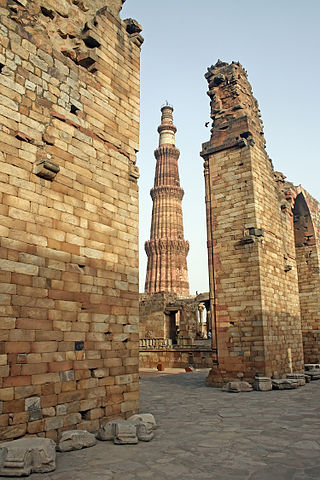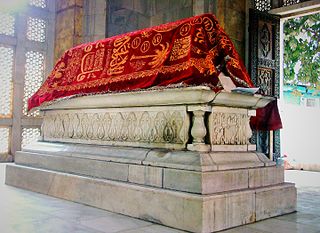
The Delhi Sultanate or the Sultanate of Delhi was a late medieval empire primarily based in Delhi that stretched over large parts of the Indian subcontinent, for more than three centuries. The sultanate was established around c. 1206–1211 in the former Ghurid territories in India. The sultanate's history is generally divided into five periods: Mamluk (1206–1290), Khalji (1290–1320), Tughlaq (1320–1414), Sayyid (1414–1451), and Lodi (1451–1526). It covered large swaths of territory in modern-day India, Pakistan, Bangladesh, as well as some parts of southern Nepal.

The Qutb Minar complex are monuments and buildings from the Delhi Sultanate at Mehrauli in Delhi, India. Construction of the Qutub Minar "victory tower" in the complex, named after the religious figure Sufi Saint Khwaja Qutbuddin Bakhtiar Kaki, was begun by Qutb-ud-din Aibak, who later became the first Sultan of Delhi of the Mamluk dynasty. It was continued by his successor Iltutmish, and finally completed much later by Firoz Shah Tughlaq, a Sultan of Delhi from the Tughlaq dynasty (1320–1412) in 1368 AD. The Qubbat-ul-Islam Mosque, later corrupted into Quwwat-ul Islam, stands next to the Qutb Minar.

Mu'izz al-Din Muhammad ibn Sam, also known as Muhammad of Ghor or Muhammad Ghori, was a ruler from the Ghurid dynasty based in the Ghor region of what is today central Afghanistan who ruled from 1173 to 1206. Muhammad and his elder brother Ghiyath al-Din Muhammad ruled in a dyarchy until the latter's death in 1203. Ghiyath al-Din, the senior partner, governed the western Ghurid regions from his capital at Firozkoh whereas Muhammad extended Ghurid rule eastwards, laying the foundation of Islamic rule in South Asia, which lasted after him for nearly half a millennium under evolving Muslim dynasties.

Shams ud-Din Iltutmish was the third of the Mamluk kings who ruled the former Ghurid territories in northern India. He was the first Muslim sovereign to rule from Delhi, and is thus considered the effective founder of the Delhi Sultanate.

Qutb ud-Din Aibak was a Turkic general of the Ghurid emperor Muhammad Ghori. He was in charge of the Ghurid territories in northern India, and after Muhammad Ghori's assassination in 1206, he established his own independent rule in Lahore, and laid the foundations for the Sultanate of Delhi.

The Mamluk dynasty, or the Mamluk Sultanate, is the historiographical name or umbrella term used to refer to the three dynasties of Mamluk origin who ruled the Ghurid territories in India and subsequently, the Sultanate of Delhi, from 1206 to 1290 — the Qutbi dynasty (1206–1211), the first Ilbari or Shamsi dynasty (1211–1266) and the second Ilbari dynasty (1266–1290).

Prithviraja III, popularly known as Prithviraj Chauhan or Rai Pithora, was a king from the Chauhan (Chahamana) dynasty who ruled the territory of Sapadalaksha, with his capital at Ajmer in present-day Rajasthan in north-western India. Ascending the throne as a minor in 1177 CE, Prithviraj inherited a kingdom which stretched from Thanesar in the north to Jahazpur (Mewar) in the south, which he aimed to expand by military actions against neighbouring kingdoms, most notably defeating the Chandelas.

The Chandelas of Jejakabhukti was an Indian dynasty in Central India. The Chandelas ruled much of the Bundelkhand region between the 9th and the 13th centuries. They belonged to the Chandel clan of the Rajputs.
The Ghurid dynasty was a Persianate dynasty of eastern Iranian Tajik origin, which ruled from the 8th-century in the region of Ghor, and became an Empire from 1175 to 1215. The Ghurids were centered in the hills of the Ghor region in the present-day central Afghanistan, where they initially started out as local chiefs. They gradually converted to Sunni Islam after the conquest of Ghor by the Ghaznavid ruler Mahmud of Ghazni in 1011. The Ghurids eventually overran the Ghaznavids when Muhammad of Ghor seized Lahore and expelled the Ghaznavids from their last stronghold.
Jaya-chandra was a king from the Gahadavala dynasty of northern India. He is also known as Jayachchandra in inscriptions, and Jaichand in vernacular legends. He ruled the Antarvedi country in the Gangetic plains, including the important cities of Kannauj and Varanasi. His territory included much of the present-day eastern Uttar Pradesh and some parts of western Bihar. The last powerful king of his dynasty, he was defeated and killed in 1194 CE, in a battle near Yamuna against a Ghurid army led by Muhammad of Ghor.
Aram Shah was the second sultan of the Mamluk Sultanate. He briefly held the throne from Lahore after the unexpected death of Qutb ud-Din Aibak before being defeated and dethroned by Iltutmish who began ruling from Delhi.
Nasir-ud-Din Qabacha or Kaba-cha was the Muslim governor of Multan, appointed by the Ghurid ruler Muhammad Ghori in 1203.
Paramardi was a king of the Chandela dynasty of central India. He was the last powerful Chandela king, and ruled the Jejakabhukti region. Around 1182–83 CE, he was defeated by Prithviraj Chauhan, who raided the Chandela capital Mahoba. Paramardi managed to recover the Chandela power over the next few years, but was defeated by the Ghurid general Qutb ud-Din Aibak around 1202–03 CE.
Trailokya-Varman was a king of the Chandela dynasty of central India. He ruled the Jejakabhukti region. Epigraphic evidence suggests that he recaptured Kalanjara from the Delhi Sultanate.
Hasan Nizami was a Persian language poet and historian, who lived in the 12th and 13th centuries. He migrated from Nishapur to Delhi in India, where he wrote Tajul-Ma'asir, the first official history of the Delhi Sultanate.
The Chandelas of Kalinjar were a royal dynasty who controlled some parts of former Chandela territory. They were a minor branch of the Chandelas of Jejakabhukti.

The Ghurid campaigns in India were a series of invasions for 31 years (1175–1206) by the Ghurid ruler Muhammad of Ghor in the last quarter of the twelfth and early decade of the thirteenth century which lead to the widespread expansion of the Ghurid empire in the Indian subcontinent.
Jatwan was a Chief and subordinate of Prithviraj Chauhan who rebelled against Qutb ud-Din Aibak of the Delhi Sultanate in 1192 CE.

The Rebellion of Jatwan was a revolt staged by Jatwan aganist the Ghurid empire in 1192 CE. The Ghurids defeated the rebel forces and Jatwan was killed in the battle.

The siege of Gwalior was a military expedition of The Ghurid Dynasty aganist the Kachchhapaghata dynasty in 1196. The Ghurids under Qutb ud-Din Aibak captured Gwalior after defeating Sulakshanapala, the King of Kachchhapaghata. Sulakshanapala surrendered to Aibak, which led to the complete end of Rajput Kachchhapaghata dynasty











